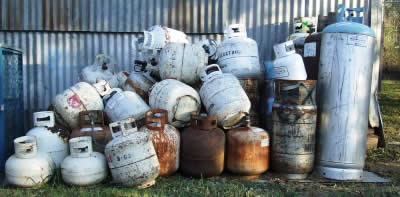
- Frequently Asked Questions - Home
- First Time Propane User
- Propane Tank Color
- Leak Test
- Abnormal Usage and Leaks
- Gallons Lost in LP Gas Leaks
- Checking For Gas Leaks
- Propane Do It Yourself
- Propane Tank Leak
- Exploding Propane Tanks
- Propane Cylinder Explosions
- Valve Open - No Propane
- Propane Tank Disposal
- Propane Regulator Freezing
- Propane BTU Content
- Propane Emergencies
Propane Tank Disposal and Recycling
Propane cylinders and tanks of all sizes sometimes have to be discarded. Although there are other uses for condemned propane tanks and bottles, people frequently just want to get rid of them. Propane tanks can be disposed of but it's important for them to be disposed of in a proper manner. Propane tanks, gas bottles and other hazardous materials will not be picked up by the local garbage collectors. In fact, improper propane tank disposal might be illegal in some areas. Propane tank disposal is a safety issue that is easily handled by a propane company or hazardous waste contractor. NEVER DISPOSE OF PROPANE TANKS IN THE TRASH.
LP Gas Cylinder Disposal and Recycling

Propane cylinders and bottles of all sizes will at some point reach the end of their useful life and because cylinders are portable and moved exponentially more than bulk LP Gas tanks, their useful life is often much shorter. When a cylinder is no longer fit for service, it will need to be properly disposed of. More than likely, the propane company or bottle filling attendant will inform the customer that the tank is no longer fit for service. Although the customer can take the bottle with them, it's better to just leave it with the company that condemned the tank. Propane companies know what needs to be done with the tank prior to disposal, and as such, is the safest and best option for the customer.
Local Propane Cylinder Disposal and Recycling - The wide availability of cylinder exchange locations may also allow for exchanging an unusable tank for a new one. Check with the exchange attendant for cylinder policies regarding this type of situation. An alternative option that is just as practical and safe is to dispose of the cylinder through services provided the local municipality. All cities and towns have solid waste departments and most all have guidelines for tank disposal. For more information or guidance about cylinder disposal and recycling, consumers can contact a propane company, fire department, or local waste management services.
Safety is an issue regarding propane tank and bottle disposal because the tanks sometimes contain a small amount of gas and propane dealers are able to safely recover the product in the tank. After all propane is safely transferred to another tank and the cylinder is depressurized, all of the valves and fittings are removed and the tank is scrapped. Tank connections, valves and gauges from unusable cylinders that are discarded are often of no further use, have little or no value and are scrapped as well. Unlicensed individuals attempting to remove gas from a cylinder or any propane tank prior to disposal can result in fire, injury or death.
ASME Propane Tank Removal and Disposal
Large stationary propane tanks are usually disposed of by simply finding a different use for them. Consumers wanting to get rid of a large LP Gas tank should contact a licensed propane company for removal. The gas service technicians have the tools and materials to properly remove any remaining gas in the tank and the means to haul it away. Individuals wanting to sell a condemned tank to a scrap yard will likely be turned away due to the fact that containers used to store hazardous materials or pressurized gases, such as propane must comply with a set of safety standards prior to being accepted for recycling. Many scrap yards won't accept propane tanks of any size due to the hazards of residual gas in the container which is why a propane company should be contacted for proper removal and disposal. As mentioned above, individuals attempting to remove of any remaining propane in a tank prior to its disposal can result in fire, serious damage or harm.
Although underground propane tanks can be removed and disposed of, the amount of work involved with unearthing an underground tank is often not the best option. The preferred method of underground tank disposal involves recovering all of the gas and pressure from the tank and then filling the tank with water or sand. The unusable underground tank poses no threat to the soil or environment when left with water or sand. Disposing of an abandoned underground propane in this manner is actually the NFPA approved procedure.